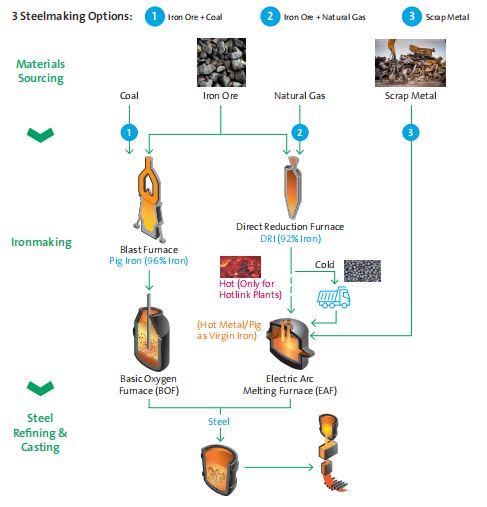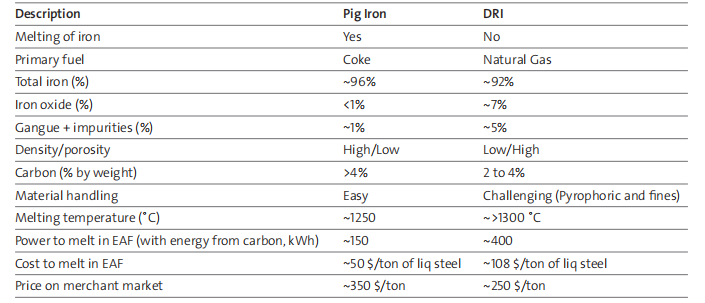Enhancing Direct Reduced Iron (DRI) for Use in Electric Steelmaking(1)
Direct Reduced Iron (DRI) is the second most viable source of virgin iron used in steelmaking after pig iron or hot metal produced in blast furnaces. DRI is produced by direct reduction of iron ore using carbon monoxide and hydrogen. Natural gas-based shaft reactors are commonly used in North and South America for DRI production while coal-based DRI is common in Asian markets. Inexpensive supply of natural gas in the United States makes DRI an attractive source of iron for steelmakers.
Figure 1 shows the different steelmaking routes, namely the integrated approach with the blast furnace, and electricity-based approach consuming DRI and scrap. In North America, more than 60% of steel is produced through the EAF route.
Figure 1: Prominent Routes for Steelmaking

In electric steelmaking, where residual elements are required to be low, between 10-30% of the charge material may need to be Ore Based Metallics (pig iron or DRI) to compensate for the impurities in the scrap and to increase the carbon content of the charge.
Pure iron units provided by the OBMs help electric steelmakers produce advanced grades of steel and control the alloy chemistry. The dilution of residuals is becoming more and more of an issue for steelmakers in markets where scrap is continually recycled, and thus steelmakers require more and more ‘virgin’ iron units in the raw materials mix to maintain low levels in the final product. Many EAF operations prefer consuming pig iron because there is a substantial decrease in electrical energy requirements and thus a corresponding increase in furnace productivity. OBMs typically have much more consistent chemistry and physical characteristics than recycled scrap iron and steel. Today, variation in scrap iron and steel chemistries can cause significant variation in operating results. The steady nature of OBMs means that they are a viable option for controlling process variation and especially increasing productivity in a controlled, safe manner.
However, not all OBMs are the same. Table 1 shows the comparison of OBMs with respect to their value-in-use for electric steelmaking. Pig iron has several advantages over DRI, namely higher metallic iron content, lower impurities, lower melting point, and higher carbon content, resulting in a lower melting power requirement. Additionally, DRI presents significant challenges with transport and storage as it generates significant fines during conveyance. From an operational perspective, pig iron appears to be a more favorable choice as an OBM source in electric Steelmaking.
Table 1: Comparison of Pig Iron and DRI

Currently, pig iron is mainly produced through the blast furnace route. Blast furnace operation and its ancillary processes contribute the largest amount of CO2 per ton of steel production, due to use of coal and coke. DRI processes, which are based on natural gas, produce less than half of the CO2 emissions of a blast furnace. Therefore, there is an underlying opportunity to remove disadvantages of DRI and bring it closer to pig iron, while keeping the overall emissions low.
In this paper, two approaches are outlined to enhance the value-in-use of DRI in electric steelmaking. The first approach is based on preheating the DRI before it goes into the electric furnace using oxy-fuel combustion, and the second is completely converting DRI to either hot metal or pig iron by melting, using oxy-fuel combustion. Both approaches are based on combustion of natural gas and/or hydrogen as fuel to minimize CO2 emissions. The next sections describe both these approaches, outlining the advantages, feasibility and potential next steps.




